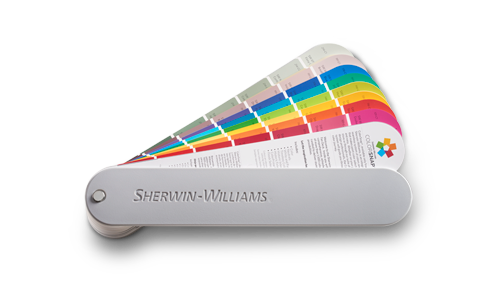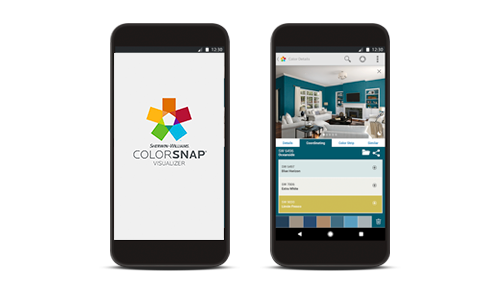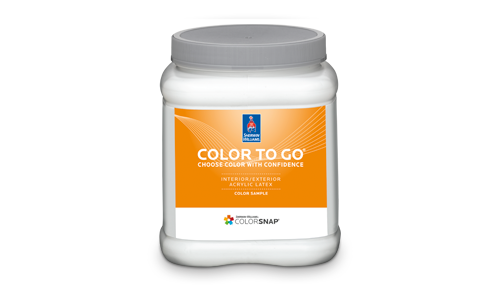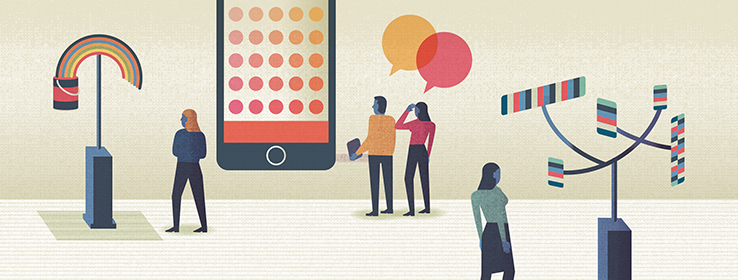Learn about the three different types of color samples — digital, paper and “wet” — so you know which to use in different scenarios.
The only way to know for sure how a color will perform is to paint a surface and observe it under different lighting conditions. But how practical is that on a day-to-day design basis? The good news is that professional color samples can get you much closer to making an informed, confident color specification prior to painting, as long as you’re savvy about what each sample type can and can’t offer. Learn about the three types of color samples so you can make the best decision on which to use.
“The goal for a designer is always to eliminate color surprises,” says Sue Wadden, Sherwin-Williams Director of Color Marketing. “My advice is to use more than one color sample type whenever possible in your design process. By using two or three different sample types at each design stage with a client, you increase color confidence and reduce second-guessing.”
PAPER SAMPLES
 EXAMPLES
EXAMPLES
- Color chips (2"x3") from the ColorSnap® Studio in-store display
- 4"x4" samples in your ColorSnap Portable or Desktop Kit
- 8"x11" oversized color samples
- ColorSnap professional fan decks
- Sherwin-Williams color cards, such as the Colormix® Color Forecast
- Many specialty color cards — including our Colormix Color Forecast — are “chipped,” which creates even more color fidelity. (These will have a slightly raised surface.)
- Free
- Come in three different sizes
- Easy to tape up to the wall and hold against textiles, finishes, etc.
- Not as accurate as a wet sample
Paper samples are a designer’s workhorse. They’re dimensional and tactile, making them ideal for giving clients a contextual sense of how paint color fits into overall project choices, from fabrics to finishes.
DIGITAL SAMPLES
 EXAMPLES
EXAMPLES
- Colors in the ColorSnap Visualizer on your desktop or mobile device
- Color swatches on the Color Detail Pages on sherwin-williams.com
- Colors in your BIM software
- Digital color files are the least accurate and consistent, as they are highly affected by your screen resolution, desk lighting and even the age and condition of your digital device.
- Free
- Usable in CAD
- Shareable from remote distances
- Interactive for clients to explore
- Least accurate and consistent, especially when printed out
Digital color samples are best for your online mood boards, CAD work and for getting clients options quickly, no matter where you are. ColorSnap Visualizer is a great tool for helping clients explore on their own.
“WET” SAMPLES
 EXAMPLES
EXAMPLES
- Color to Go®
- Color drawdowns (a large painted sample from the can of tinted paint to show actual color and sheen)
- Color to Go samples can be picked up from one of our 4,200+ stores in any of our 1,500+ colors. They come in small Twist-n-Pour containers that cover approximately 75 sq. ft.
- Highly accurate
- Can help move conversation quickly from color to paint and paint finish choices
- Comes with cost
“Wet” color samples are most useful for “closing the deal” on color decisions. If you’re going to invest time and effort in wet samples, it’s best to ensure you and your client have already narrowed your options.
Ready to explore the complete range of Sherwin-Williams color samples and ColorSnap tools? Go to www.sherwin-williams.com/architects-specifiers-designers/color








